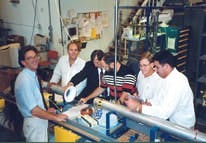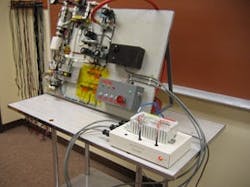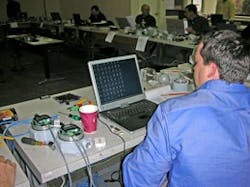If you’ve ever sat through a death-by-PowerPoint training session, you know how boring and ineffective one-size-fits-none training can be. Fortunately, training by internal personnel, system integrators, and vendors is evolving to fit the needs of process control end users and to satisfy management demands for real returns on training investments.
Why Train?
Before we look at specific training methods, let’s answer the question, “why train at all?” The first and most obvious reason to train is to increase productivity. Productive employees increase overall company productivity and justify training expenses.
But there are many other reasons to educate employees. “We train so we can accomplish tasks internally without depending on contractors,” says Jerry Wilkey, electrical foreman at Lehigh White Cement, Allentown, Pa. Doing work with existing staff saves money and time, and can also improve morale.
Many end users think training is a great way to solve vexing problems. “Time away gives the employee time to develop new perspectives on solving nagging problems,” opines Jeff Waufle, IT technical services supervisor at Las Vegas Valley Water District in Nevada.
Training also enables teamwork, which can then be brought to bear on other problems. “Training gives us a much larger pool of people to solve customer’s problems,” says Joe Malter, a senior project engineer with system integrator PSI Controls.
Training opens the door to new problem solving methods. “Education can introduce our clients to technologies and solutions they didn’t realize existed, helping them to solve difficult problems,” reports Marc Immordino, product training manager at Wago, Germantown, Wisc. Wago makes electrical connectors and decentralized automation components such as I/O devices, PLCs, power supplies, and signal conditioners.
Training can show employees new and better ways of doing things. “Training enables people to recognize opportunities for improvement beyond requested scope,” according to Dick Ciammaichella, director of control systems integration at CSIA member, the RoviSys Co..
FIGURE 1: THE TRAINING TABLE
Hands-on training in a lab environment with actual instruments used in the students’ process plants is a training best practice. (Photo courtesy of FCI.)
Employees become more effective when trained, but while they’re in training, others must step in to take their place. This can be a good thing. “We find that employees covering the duties of an employee in training get real-time practice in their back-up tasks. This increases our bench strength,” says Waufle.
Companies must sometimes train to address very specific operational requirements. “Training our employees with automation technologies helps us retain valuable data,” reports Joe Mauro, East Coast LFG manager for Minnesota Methane/United Gasco, East Brunswick, N.J. “In our business, lost data can cause large economic losses. If we lose flow or temperature data, local environmental agencies can and do levy large fines for these lost data points.”
Besides direct operational benefits, training helps companies attract, retain and motivate employees—an especially critical benefit in process control industries, where the shortage of technical personnel is chronic.
Keep Your Best Employees
“Training increases employee retention and loyalty. It’s myopic and incorrect to assume that the employee will take the training and move elsewhere. Departure is for other reasons,” says Geoffrey Kerr, electrical engineering manager at automotive covering maker, The Haartz Corp., Acton, Mass.
Others second Kerr’s opinion. “Training gives employees a sense of loyalty to the company, and it also creates a team identity for groups of people that train together,” says Ethan Frounfelker, a sales engineer at electrical distributor Mercer Midwest of Milwaukee, Wis. Employees that feel kinship within their firm are much more likely to stay.
Workers often cite stress as a major reason for leaving a job, and training can relieve stress by making workers more confident and comfortable with technology. “Training creates a less stressful work environment, and eases the stressful transition period for new employees or for an employee changing jobs within the company,” observes Stephen Raines, a project engineer with textile company Albany International.
Training also increases morale. “Employees feel important after training because their company is investing in them, and helping them grow professionally,” says Kelly Hoffmann, director of learning and development at system integrator and CSIA member Maverick Technologies. “This goes a long way in retaining talent, and it keeps the workforce prepared for the future by allowing the company to expand and grow with emerging trends and technologies.”
Training makes managers’ jobs easier for other reasons as well. Managers can delegate more to a trained workforce. “Training our employees thoroughly establishes a clear line of accountability and responsibility for our workforce,” relates Jennifer Rogers, marketing director at wire, cable and networking components distributor Accu-Tech.
Finally, some companies see training as indispensable, and can’t imagine corporate life without it. “What would happen to our company if it was staffed with untrained employees?” asks Jim Reizner, section head of corporate engineering at Procter & Gamble, Cincinnati. “The answer is simple—our company would fall apart. We need to invent new products, manufacture them, and sell them to our customers. We need to delight consumers. If this doesn’t continue to happen, we’re out of business. To be able to execute each of the many steps required to ensure that we continue to delight our consumers with our products, we need highly trained people. There is no other way for us.”
Training Challenges
Good training isn’t easy, and several obstacles need to be overcome. Giving an employee time away from work for education is the chief challenge for companies that wish to train their staffs. “Our biggest automation training challenge is being short an employee while that person is away at training,” says Lehigh Cement’s Wilkey.
Money comes in a close second. “Due to the shortage of operating staff and the relative cost, many process end users would prefer not to send their staff for extensive outside training,” according to Craig Resnick, research director at ARC Advisory Group.
In addition to time and money, the timing of training is a challenge. It’s a use-it-or-lose-it situation. “We have to use training right away for it to be effective,” says Jeff Silvernale, senior development engineer at Vertellus Health and Specialty Products, Indianapolis. “If we’re trained on something that doesn’t need our input for the next few months, we don’t remember much and often have to look in the manual and call our vendor’s customer service.”
Keeping up is another problem. “The biggest training challenge is staying current with a particular platform or vendor software package. Vendors continue to offer new software revisions or new add-on packages, and it’s difficult to stay current on everything,” says Phil Murray, principal at system integrator FeedForward.
Be Specific
The best training is very specific to an end user’s particular wants and needs, but this is also the most expensive and time-consuming type of training course to prepare. Consequently, many vendors present generic material, so users have a hard time finding training specific to their industry and their processes. “We often find that vendors’ automation training classes are too generic, and don’t cover our specific industry,” reports Waufle of the Las Vegas Valley Water District.
On-the-job training is surely the most prevalent form of education in any industry, but such training really can’t be effective without the help of mentors. However, providing the right mentors at the right time and place can be quite difficult. “Being a global company, we have many new smaller organizations worldwide that are quite remote from our major bases in the U.S. and Europe. Training these people is a challenge because there may be no local people to serve as mentors, or because of the remoteness of the locations and cost of travel for training,” says Reizner of Procter & Gamble.
How to Train
First, how not to train: Get a large group of people of widely divergent skills in a room for eight hours, and subject them to a PowerPoint presentation/lecture that covers topics not specific to their needs. Make sure the training is off-site so that each employee is away from work for a long time and expense is maximized. Don’t test on what was learned, and don’t apply the training to situations in the students’ plants.
Sound like courses you’ve attended? Fortunately, there are ways to avoid common mistakes.
Web-based training minimizes the impact on work schedules. “A trend is to provide PC and web-based simulation system training,” says ARC’s Resnick. “The training materials, many of which take advantage of interactive simulation software, can be made available anywhere there’s a PC and an Internet connection.”
Online courses that let students study at their convenience are popular. (Photo courtesy of Accu-Tech.)
Providing courses via the web can allow each trainee to schedule his or her training at the most convenient times and places. Advanced interactive web-based training can also allow students to proceed at their own pace.
Customization of training is a huge time-saver because it’s more efficient. “We train two distinct groups in separate classes—operations personnel and technical/engineering personnel,” reports Murray of FeedForward. “We teach operators fundamental loop monitoring, manipulation skills and display navigation—all using actual plant applications as the training environment in an offline system. Engineering training covers system administration and control configuration. We use controller emulation in a PC and emphasize hands-on lab learning versus extensive lecture.”
Another systems integrator finds that his clients also prefer real-world training. “We train our clients on target hardware using the same graphics that the plant will install at startup. We also use simple simulations, and we work with operators and engineers during commissioning,” says Ciammaichella of RoviSys.
The Las Vegas Valley Water District holds out for one-on-one training. “Almost all of our training is via vendor-offered skill improvement classes that are single-student,” say Waufle. “There is no better way to teach than one-on-one.”
One solution to the use-it-or-lose-it problem is just-in-time training, but that presents issues of its own. “Many of our projects are on a fast track, often with some new twist. The biggest training challenge is just-in-time or just-in-case. Do you train someone hoping they will work on a future project, or do you train at the start of a project? Timing with available classes makes just-in-time training very difficult to schedule,” according to Mauro at Minnesota Methane/United Gasco.
On-the-job training doesn’t work without mentors. “The majority of our training is on-the-job, where each person’s capabilities are matched to a specific project assignment. New people are typically matched with more experienced mentors to insure they get specialized training that meets their specific needs,” says Reizner of Procter & Gamble.
The challenge for all training plans is to maximize training effectiveness at a reasonable cost without taking employees away from work for an inordinate amount of time. Following training best practices can go a long way towards addressing these challenges, and can keep your company and its employees at the forefront of process control.
WHY TRAIN?
Increase productivity- Accomplish tasks internally instead of using outside resources
- Develop new perspectives to solve nagging problems
- Give replacement employees real-time practice in their back-up tasks
- Impart the ability to recognize improvement opportunities
- Boost morale
- Create consistency in implementation
- Improve safety
- Reduce employee stress
- Increase employee confidence
- Help attract and retain employees
- Refresh knowledge
- Develop sense of camaraderie
TOP TRAINING CHALLENGES
- Taking time off from work
- Paying for courses and travel
- Using what’s learned immediately
- Finding courses specific to your industry and processes
- Finding courses customized to each student’s aptitude and needs
- Providing the right mentor for on-the-job training
TRAINING BEST PRACTICES
- Train in small groups
- Keep sessions short
- Make training hands-on
- Accommodate employee schedules
- Measure what’s learned
- Apply knowledge immediately
- Use mentors for on-the-job training
- Make training relevant to your industry and processes
How Vendors Train End Users
Robert Vogel, director, support services, for system integrator Advanced Automation, gives his take on how the company trains its process industry clients.
“We find it’s imperative to provide targeted and effective training that give personnel the ability to operate, support and maintain their systems. We have been designing and delivering training internally for more than 20 years, but in the past two years we have also been providing training as a deliverable to our clients.
“How does a company that’s focused on manufacturing technology solutions create an effective training system? By using many of the same strategies in our project engineering discipline to engineer training to meet clients’ needs.
“By effectively using the latest adult-learning models, focusing on the business goals and the driving reasons that justify training, and using skills-targeted, learner-based training and assessments, we’ve been able to ensure that training will increase employee effectiveness.
“We focus on the outcome each client wants to achieve. While this may seem obvious, it’s too often the missing step in developing a training program. We partner with each client to determine goals. That’s the starting point of any effective training program.
“Once the program goals are established, we consider the student’s skill sets and background. Using them as a starting point and framing them in the training program’s goals, we can focus the training on the most needed skills.
“There’s a knowledge gap that needs to be bridged by the training: determining where the learners are and where they need to be. This gap is ascertained by conducting an extensive needs analysis that then serves as the roadmap for each individual’s training.
Our training programs use each new level as the foundation for the next course, so that training level 101 will lead to 201, and to 301, etc.
Often, our task is to provide a base level of understanding for the majority of students. However, we usually find that some students are already knowledgeable in certain parts of the training curriculum and need more advanced training.
“With the stepped approach, we can target the instruction at different groups of students, avoiding the drink-from-the-fire hose approach that is typical of many canned courses. It also eliminates the boredom associated with one-size-fits-all training.
“Classes are typically short, about four hours, and oriented towards hands-on instruction. These two points have proven to be the most effective method to keep students focused.
“A common training program our customers request centers around improving troubleshooting skills. We take students through the basics, but we incorporate the client’s actual equipment and drawing packages, and focus on areas where the students have specific issues. The students get trained on their own systems, creating an immediate positive impact on mean-time-to-repair.
“Post-training program assessment testing plays a vital role in the entire experience and becomes the roadmap for future training. It’s planned up-front, before training development begins, and ensures that pre- and post-training analysis will provide a true measure of the success of the training.
“By assessing the learners in the analysis phase as well as after training, success can be measured. Most important, we can be certain we have met our client’s goals.”
The University Approach
Carlos Tavora, a professor of electrical and computer engineering at Gonzaga University in Spokane, Wash., talks about his school’s automation training efforts.
Control: How does your university train its students for careers in automation?
Tavora: At Gonzaga, we offer “Automation” as a senior elective for computer, electrical and mechanical engineers. Students must have a solid understanding of engineering fundamentals as a prerequisite, so they can fully understand the impact that automation has on manufacturing processes, equipment operation, safety, production costs and plant cultures.
The automation course emphasizes the use of programmable controllers. The design principles presented evolve from simple to complex, and progress from ladder logic and instruction list to sequential function charts, function blocks and structured text. Students progress from a simple operator panel to designing an interactive graphic operator station.
In the lab, they learn how to implement and test control strategies. They start by programming a series of basic control algorithms, as well as operator stations, followed by project assignments related to more complex systems.
One of these projects involves developing control strategies for a conveyor with an item-dispensing hopper that fills containers of different sizes. Another project is controlling a system that drills several holes into a part. This system has electro-pneumatic actuators, and provides students the opportunity to learn how to manage solenoid valves, pneumatic cylinders and associated sensors.
Control: What are the biggest automation training challenges you see?
Tavora: Conveying to students the importance of understanding the manufacturing process, how to take into account all safety issues, and how to design a system that’s appropriate for the education and experience of operators and maintenance personnel.
Control: Besides increased productivity, what benefits can a company realize from training its employees?
Tavora: Employees are in general more satisfied when they have some control over the environment of their work. Enabling employees to understand manufacturing processes and how they can test different control strategies through simulation can increase job satisfaction and provide innovative control ideas. Greater awareness of safety procedures and a motivation to progress in the career ladder can also be fostered by training.
Latest from Asset Management

Leaders relevant to this article:







